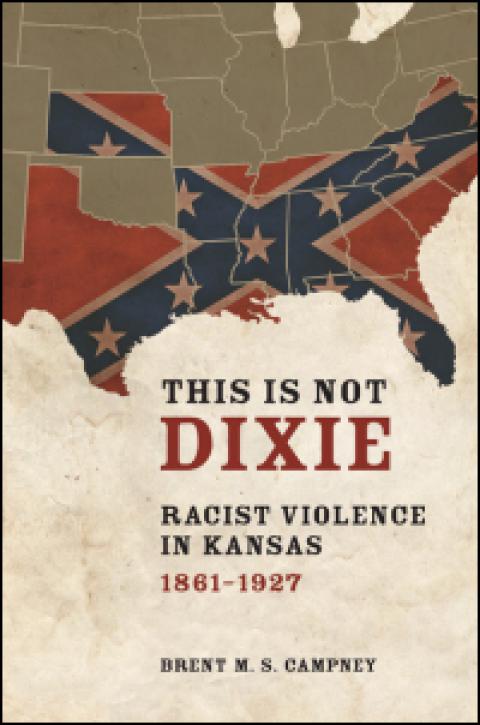Brent M. S. Campney. This Is Not Dixie: Racist Violence in Kansas, 1861-1927.
University of Illinois Press, 2015.
ISBN: 978-0-252-03950-8
Growing up in the small county seat town of Pratt in the 1950s, racial segregation was common. Not in the schools, which were integrated, but there was a large modern swimming pool for whites only, and a tiny pool for blacks only. Racist language was also common. The owner of a dry cleaners for which I delivered clothes would not accept garments from blacks, with the exception of a dignified man who was a professor in a Southern college. His education and modest bearing, I was told, made him special. Around 1956 a group of black men from Wichita suddenly integrated the large swimming pool, and one could see that times were changing. The small pool soon closed.
It was only much later that I even heard of any lynchings in Kansas—one instance, as I recall, in Fort Scott. So when Brent Campney gave a talk on racist violence in Kansas at a “Border Wars” conference at the Kansas City Missouri Public Library a few years ago, my eyes were forever opened. Now he has published a ground-breaking book which will surely alter our entire understanding of the real contours of racism in Kansas.
The “received wisdom,” or what Campney calls the Free State myth, is that because of those same Border Wars of the 1850s, the resolute stand of abolitionists such as Captain John Brown, the admission of Kansas as a Free State in 1861, and the Union victory in the Civil War, blacks were broadly welcomed into the State, and found a better life here. It’s a compelling vision, for who does not want to consider one’s native land to be heroic?
Campney demonstrates that in the early Statehood period of the 1860s, blacks were needed to work in the cities and farms, and as soldiers in Kansas regiments. Even then, there were repeated episodes of racist violence.
Campney posits five kinds of such violence: lynching, race riot, mobbing, killing-by-police, and homicide. His narrative reveals that scarcely any towns or cities escaped these incidents. “A focus on racist violence convincingly demonstrates that most white Kansans were racial conservatives who neither accepted ‘the new population’ nor broadened ‘their definition of liberty.’ Instead, they adhered to an unwavering contempt for blacks. Most were rural or urban whites who worked and lived alongside the unwanted black immigrants.”
We generally think of racial turmoil and hatred as characteristic of Reconstruction in the South. Yet the same period in Kansas saw horrendous violence: “In 1873 mob members in Dodge City first shot their victim repeatedly. When he crawled into a nearby store, they dragged him back outside, filled him with bullets, kicked out his teeth, and for good measure killed his mule.” Similarly, “in 1870, a mob in Atchison hauled George Johnson from the jail, tied him to one of their horses, dragged him around the town, and then hanged him.” This book documents literally scores of such episodes.
While there many killings—including burning the victim at the stake in Leavenworth in 1902, mobs burned houses and even schools. Blacks often fled, but there were always instances of resistance, such as armed black men surrounding a jail. Campney and other historians acknowledge that during the first six decades, but especially in the 1870s, lynchings of whites outnumbered those of blacks, but these were often alleged horse thieves. Blacks suffered because they were black.
Over time, the judicial system developed to control these outrages. There were more successful rescues by armed blacks, and even by law enforcement officers. In spite of the arrival of the Ku Klux Klan in Kansas in the 1920s, State leaders such as William Allen White successfully opposed them.
Historian James Loewen famously documented the extent of racially exclusive communities in his book Sundown Towns. There were many such in Kansas. We can now better understand the social context from which they sprang.
The present book shows how abolitionists like Daniel Anthony courageously rejected racism, but more and more, the Free State myth served as a cover for moderates “looking the other way.” By the 1880s, Kansas was moving into modes of racial segregation—and we can now see the background for the Brown vs. Board of Education case in Topeka. The Supreme Court’s decision of 1954 began the process of outlawing segregation in the United States.
Back to the town of Pratt: In 1905 Bert Bean was killed by police. In 1909 and 1922 there were threatened lynchings, and in 1910 George Washington was mobbed, his house riddled with bullets. I never heard of any of these while growing up there. Ferguson, we now understand, is everywhere.
The book’s documentation is exhaustive, and several maps usefully locate the types of incidents occurring around the State. The University of Illinois Press again meets the highest standards for publishing dramatic new scholarship.
[Fred Whitehead was born in Pratt, Kansas. Whitehead is freelance poet, writer, editor and freethought historian. His latest book, The Poetry of Resistance: 33 Contemporary American Voices was published in 2014. http://www.amazon.com/The-Poetry-Resistance-Contemporary-American/dp/09…; Whitehead edited Freethought on the American Frontier (1992), with Verle Muhrer. In 1989, Whitehead was given an Award for Exceptional Service by the Kansas Writers Association.]


Spread the word